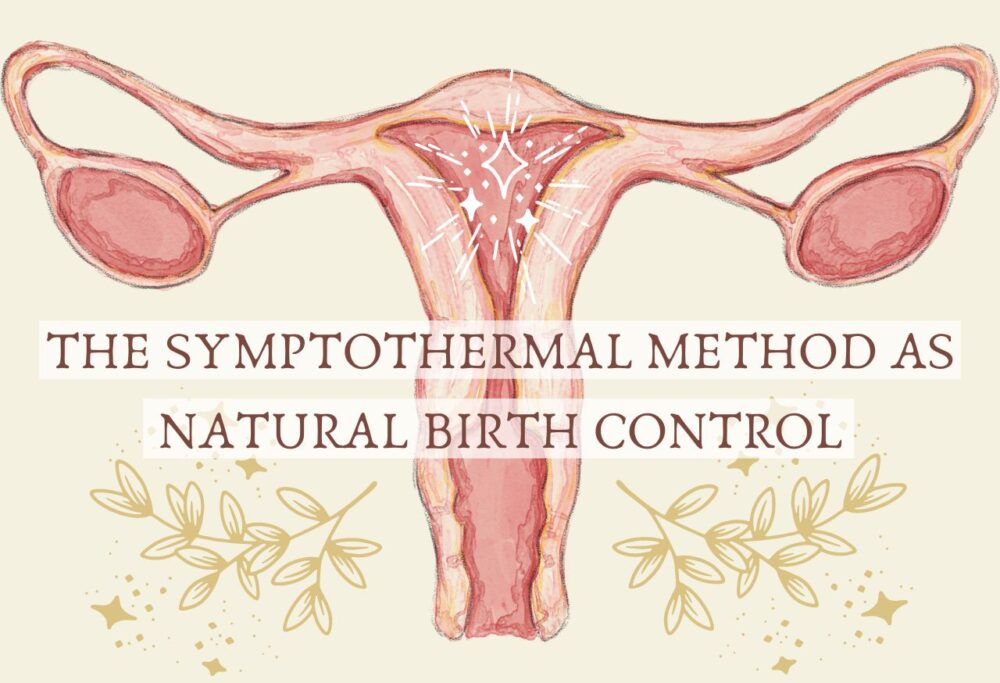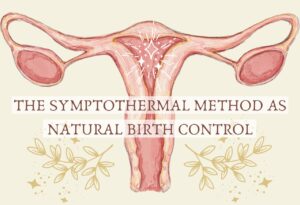This blog post is about the symptothermal method as a natural option to hormonal birth control.
The search for the best non hormonal birth control has been one of the biggest and most interesting searches in my life. What I found also prove to be one of the most important changes in my natural lifestyle!
If there is one thing I’ve always known deep inside me, it’s that I don’t want to shut my menstrual cycle down as a ”solution” to not get pregnant or to ”solve” various menstrual cycle problems.
Not only do I not want to ingest synthetic hormones daily, but shutting the entire female reproductive system down sounds incredibly medieval to me. I actually find it really unjust that girls almost always are expected to start taking hormonal birth control as soon as they reach a fertile age.
It should not only be a woman’s responsibility to prevent unwanted pregnancy.
As if it is our responsibility alone.
As if it’s the obvious choice to medicate the female body into submission for the sake of being ”safe” everyday. Many women are suffering from multiple side effects on hormonal birth control. But today it’s just accepted (if not expected) that they compromise their mental and physical health to protect themselves reproductively. When women are on hormonal birth control, men don’t need to take any responsibility for their fertility at all.
The responsibility is very unevenly distributed in my opinion.
Even if the option of hormonal birth control definitely should exists, we should be properly educated about all the options and their effects on our bodies. That way we can make an informed choice for what’s best for us individually.
But right now, we are not given all the options. We are not given the choice to get to know our bodies and our cycles. To flow with its phases and become literate to the language of our female body. The only options I was offered were: go on a form of hormonal birth control, get an IUD or suffer the consequences (which, in their opinion, was eventually getting pregnant and continue having horrible cramps).
✧ Read: How To Relieve Menstrual Cramps Naturally
But then I discovered there was another way. A way that is getting more and more known every day, which I’m so happy about! I hadn’t even heard about it until I was in my early twenties and had had a cycle for almost a decade already.
Let me introduce you to a method that has completely revolutionized my life and gifted me with incredible knowledge of understanding my female biology:
The symptothermal method.
Basic biology fertility facts
Before I go into detail about the symptothermal method, there are some important basics to learn that will help you understand how female fertility works.
-
- Women are only fertile 24 hours each month.
Yes you read that right. One day a month. When the egg is released at ovulation, it will die within 12-24 hours if it isn’t fertilized.
- Women are only fertile 24 hours each month.
-
- Women only ovulate ONCE each cycle. If more than one egg is released, it is within the same 24 hours.
Which means that after ovulation, it is impossible to get pregnant for the rest of the cycle until menstruation.
- Women only ovulate ONCE each cycle. If more than one egg is released, it is within the same 24 hours.
-
- Men are fertile every second of the day and sperm can survive up to 5 days inside the female reproductive tract.
The survival of the sperm depends on several conditions, like sperm health and if fertile cervical mucus is present.
- Men are fertile every second of the day and sperm can survive up to 5 days inside the female reproductive tract.
-
- There is a possibility to get pregnant from unprotected sex 6 days a month.
The 24 hours of ovulation and the possible 5 days of sperm survival, leaves a potential fertile window of 6 days a month.
- There is a possibility to get pregnant from unprotected sex 6 days a month.
Now with these biological facts in mind, it will get much easier to understand how the symptothermal method works and why it is so effective. Even if women technically only are fertile up to 24 hours a month, the fertile window is up to six days. This means that you could get pregnant if you have unprotected sex 5 days prior ovulation. Because the sperm could be waiting patiently for the release of the egg. This makes it necessary to abstain or use a barrier method during this fertile phase. During the infertile phase you won’t need a barrier method to avoid pregnancy, because it’s simply not possible.
This is basic biology.
Now it’s maybe also easier to understand why I find expecting women to go on hormonal contraception unfair. Why are women the ones that have to shut their reproductive system down, when they’re only fertile one day a month? When it in fact are men that are fertile every single second of the day for most of their lives.
Why are women the ones that have to suffer from possible side effects these contraceptives have on our bodies? Why is it considered normal for women to suffer to protect themselves reproductively? Why is it accepted that men don’t have to think twice and the entire responsibility lays on women? Nobody actually thinks twice about it because it’s the woman that bears the child and not the other way around. But it takes two to get pregnant…
What is Fertility Awareness?
Fertility awareness is such a revolutionizing concept, its efficiency now proven with science. Even if I believe it has been known by wise women for centuries, the incredible knowledge hasn’t been acknowledged until a man decided to officially prove it in a scientific study.
Fertility awareness methods (FAM) are natural birth control methods where a woman actively observes and documents the fertility signs in her body every day, to conclude if she’s in an infertile or fertile phase in her menstrual cycle.
Fertility awareness will not only help you to prevent unwanted pregnancy but also teach you about how your body works. I know so many women out there are looking for a natural birth control option, but are too afraid to trust their own body and capability to learn how to understand it. I was one of them.
The symptothermal method is the most effective fertility awareness method. It is however important to note that there are several types of fertility awareness methods. They also all have different effectiveness rates as well. Here are some of the most known and practiced.
Different fertility awareness methods
-
- Standard day method/Rhythm method: Tracking the days of your cycle and identifying the fertile window based on the general length of your cycle. This is the least effective fertility awareness method and is not recommended.
-
- Billings ovulation method/Creighton model/Cervical mucus method/Two day method: Consists of tracking cervical mucus the entire menstrual cycle and decide if you are fertile or infertile based on that.
-
- BBT method: Measuring your basal body temperature (BBT) every morning and only consider yourself infertile after a three day consequtive rise in BBT, until you start your next menstruation.
-
- Sympto-thermal method: A combination of tracking BBT, cervical mucus and sometimes also cervical position to conclude a fertile or infertile day. This is the most effective fertility awareness method.
The last named method is the one I personally use and will explain in detail in this blog post!
The Symptothermal Method
The symptothermal method is the most effective fertility awareness method. It consists of tracking and documenting (also called charting) two or three primary fertility signs every day and conclude if it’s a fertile or infertile day in your cycle. The three primary fertility signs are basal body temperature, cervical mucus and cervical position. If you are infertile it is safe to have unprotected sex and not get pregnant.
If you however are fertile, you MUST use a barrier method or abstain if you want to avoid the possibility of getting pregnant.
How effective is the symptothermal method?
The symptothermal method has proven to be 99.6% effective with perfect use and 98% effective with typical use at preventing an unwanted pregnancy. To have something to compare it with, the perfect use of the condom is 98% (typical use 82%). The perfect use of the pill is 99.7% and the typical use 91% effective. The copper IUD is 99.4% and hormone IUD 99.8% effective. As you can see, the symptothermal method has about the same efficiency with perfect use as all the other birth control options offered by the regular healthcare system. Even better, it’s much more effective with typical use compared to the pill. And it’s without all the possible negative side effects!
The three fertility signs
Okay so lets get into what the different fertility signs are and how exactly you chart them. There are three primary fertility signs: basal body temperature, cervical mucus and cervical position.
There are of course more fertility signs. But they are not primary because they are individual and unique to your own body. While tracking the primary signs, you will soon discover your more unique signs. You can later consider them in your conclusion of having a fertile or infertile day. However, as they are an additional sign, you must not rely on these alone and always track at least two of the primary fertility signs.
It’s also important to note that these fertility signs only are valid if you are NOT on hormonal birth control. If you are on hormonal birth control, the three fertility signs will not be present because you won’t have a real menstrual cycle.
✧ Read: How To Get Your Period Back Naturally
Basal Body Temperature
Basal body temperature (BBT) is the body’s lowest resting temperature. You always measure it exactly when you wake up.
How to take your basal body temperature
You wake up naturally or by your alarm and immediately take your temp before doing ANYTHING ELSE. No getting out of bed, not drinking water, just wake up and put that thermometer in your mouth. You must have a thermometer that measures one hundred of a degree. That means a thermometer that gives you something like 36.54°C or 97.65°F. You should also measure it around the same time everyday. This is to avoid big fluctuations in your chart because the longer you sleep the higher your BBT tends to get. You measure your BBT every single day of your cycle.
Why is basal body temperature a sign of fertility?
In your follicular phase, which means from the start of your menstruation up to ovulation, your BBT is lower. On average the temperature lies between 36.22-36.56°C (97.2-97.8°F). When you HAVE ovulated, the hormonal shifts in your body causes BBT to rise noticeably, about 0.3°C (less than 0.5°F). The temperatures will now range from 36.55°C (97.8 °F) and higher. You can conclude ovulation has happened by having high temperatures for three consecutive days. When you have concluded that ovulation indeed has happened, you are infertile for the rest of your cycle.
Things to take in account when measuring BBT
There are some rules you need to follow here. Like not measuring when you are sick, have a fever, consumed a lot of alcohol the night before or have slept for less than 5 hours. These things all mess with your BBT and can make your measurements invalid. Just skip the measurement and conclude it as a fertile day when you are not able to get a valid BBT. Also be sure to measure BBT around the same time every day to not get confused by high temps from sleeping in.
Cervical Mucus
You know the slimy blobs you find in your underwear sometimes? That is most likely cervical mucus. Cervical mucus are different kinds of fluids that the cervix produces. The quantity, consistency and color of the cervical mucus changes depending on where in your menstrual cycle you’re at.
How to check your cervical mucus
You check the type of cervical mucus every time you go to the toilet. You can observe the mucus both in your underwear and on the toilet paper when wiping before and after you’ve gone to the toilet. If there is cervical mucus present, you examine it by looking at it and feeling its consistency between two fingers to determine the type of mucus.
The different types of cervical mucus
Dry: There’s no cervical mucus on the toilet paper when you wipe and nothing noticeably in your underwear. You are considered infertile.
Sticky: There’s very little cervical mucus. It feels sticky between the fingers (almost like glue) and is often white. You’re in the very beginning of your considered fertile days. This type is considered infertile.
Creamy: There is a considerable amount of cervical mucus, which is easily spotted in both underwear and on the toilet paper. It’s cloudy or white, lotion like and creamy in consistency. This is the type of cervical mucus that’s around when you’re well on your way to ovulation. This is considered fertile cervical fluid.
Egg white: There is a lot of cervical fluid present, sometimes so much it’s soaking your underwear. It feels slippery when you wipe. It’s clear, watery, stretchy in consistency and resembles raw egg whites. Sometimes it can also be streaked with a little blood. These are the slimy blobs I was talking about! Egg white quality mucus is the most fertile cervical mucus there is. Seeing this means you are highly fertile and about to ovulate at any time.
Why cervical mucus is a sign of fertility
The cervix produces cervical mucus when the hormone estrogen is rising and the egg is ripening. From the beginning of your cycle up to ovulation, estrogen slowly rises and reaches it’s peak at ovulation. When you start to see cervical mucus, it means that things are happening in your ovaries. The more estrogen present in the body, the more cervical mucus there is and the closer you are to a ripe egg and ovulation. Egg white quality cervical mucus is produced when estrogen is at its peak. Which is when you are about to ovulate and therefore is considered the most fertile cervical mucus.
Things to take into account when observing cervical mucus
In the symptothermal method, you have to consider all cervical mucus fertile. This means that as soon you detect any type of cervical mucus, even if it is sticky, you should consider yourself fertile. Only on dry days can you consider yourself infertile. You should also be careful of things that can possibly mask your cervical mucus. These are things like menstrual blood, arousal fluid, semen or spermicides. When you can not properly observe your cervical mucus, consider yourself fertile.
Cervical Position
The third primary fertility sign is the position of the cervix. The cervix is the outer end of your uterus that sticks out into the vaginal canal.
How to know the position of the cervix.
You measure the position of your cervix simply by feeling it with your fingers. Always thourougly wash your hands before! Squat down and stick a clean finger with trimmed nails into the vagina to locate the cervix. Determine the position of it (low or high), the feeling (firm or soft) and the size of the opening (closed or open).
When you’re not fertile, the cervix is positioned low in the vaginal canal and feels harder to touch (comparable to the tip of your nose). Also the opening in the middle feels small and closed.
When you are fertile, the cervix is positioned much higher in the vaginal canal, feels soft and mushy (comparable to your lips) and the opening in the middle feels larger and open.
Why it’s a sign of fertility
During the menstrual cycle the position and feel of the cervix changes because of hormonal fluctuations. Estrogen increases when you’re nearing ovulation and the cervix responds to it. It does that by going higher up in the vaginal canal, getting softer and more open so that potential fertilization can occur more easily. When estrogen drops, the cervix responds by dropping down again, getting firm and closing up.
Thing to take into consideration
Tracking your cervical position is not a must in the symptothermal method. It’s a primary fertility sign you can use in addition to the other two. This way you can be even more certain of your fertility conclusion for the day. It’s also good to know that if you’ve ever given birth, the opening in the cervix may not fully close and therefore always feel a bit open. Another thing to note is that you shouldn’t check your cervical position after sex, because it will have moved further up into the vaginal canal to ”make room”. Ideally, check it the same time and in the same position.
Benefits of the symptothermal method
-
- An effective non hormonal birth control method that’s completely natural and without any negative side effects.
- Literacy in the language of your own body.
- A collection of important data that reflects your health. You will be the first to know when something is off because it’s noticeable in your chart.
- Proof on how your lifestyle choices & different food you eat affects your health (by noticing how they affect your chart)
- Feeling super empowered and in charge of your own fertility, which is your birth right.
- Confidence in yourself.
- More money in your pockets because it’s free once you’ve learned it.

Common questions about the symptothermal method.
How do I start using the symptothermal method?
If you’re serious about starting the symptothermal method I highly encourage you to educate yourself further on the topic. My favorite book about fertility awareness is ”Taking charge of your fertility” by Toni Weschler. It is absolutely packed with information about the symptothermal method and female biology.
If you want to start using the symptothermal method as birth control right away, it’s really recommended to get educated by a fertility awareness educator. Even if it is possible to learn it by yourself (like I did) it is highly recommended to get educated by an expert to ensure you’re learning the method correctly and ensure perfect use.
Informational sources about FAM, female health and the symptothermal method:
✧ Taking Charge of your Fertility – Toni Weschler (The holy grail book on fertility awareness)
✧ Vulverine.se (A Swedish reproductive health practitioner. NOTE: it’s in Swedish)
✧ Dr. Jolene Brightens Instagram (A functional medicine naturopath physician and expert on women’s hormones)
✧ Wombenwellness.com (Sacred & scientific education about female biology and embodiment)
✧ Studies provived in the Sources section in the end of this blog post.
Why haven’t I heard about the symptothermal method before?
Many people, including doctors and regular health practitioners, are real quick to dismiss any fertility awareness method.
They simply believe (and get taught) that women, especially younger ones, are to easily confused and not disciplined enough to observe and understand their body signals correctly. And that they will make mistakes that lead to unwanted pregnancy. Instead of teaching women how to understand their own bodies and hormones correctly, it is much easier to just prescribe and let them depend on hormonal contraception.
It is also interesting to note that the global contraceptive market size was estimated USD 26.9 billion in 2021. When women are literate to their bodies there isn’t any long lasting money to be made. Once they learn it they can implement the knowledge their entire life and possibly even teach their future daughters.
They can even monitor their own health with the knowledge! So heck why recommend a female empowering practice when there is money to be made by women being oblivious to their own bodies? Isn’t it funny how making profit always seems to be the primary goal? It makes me angry but also fuels me with a passion to spread the word and educate other women that there most certainly IS an effective option to hormonal birth control.
The symptothermal sounds scary and difficult…
I know the feeling. I started my fertility awareness journey a bit skeptical about it all. That’s why I used a fertility monitor in the beginning. I used it as a kind of back up in making the right fertility conclusion for the day. It made me feel safer and eventually gave me the confidence to start trusting myself and my own ability to conclude fertile and infertile days. Even if this is the route I took, I want to say that you definitely can start the symptothermal method without first using a fertility monitor!
✧ Read: The Natural Birth Control Method I Use: Effective And Hormone Free
Today I can say I confidently only use the symptothermal method as birth control, which I’ve now done successfully since 2019. No mistakes, no pregnancies. I taught myself by collecting a hell lot of information from books, scientific studies, podcasts, documentaries, doctors, courses and fertility awareness educators and integrating what I learned into my life.
Give yourself time to educate yourself and get to know how the three primary fertility signs look like in your own unique body. Use the three primary signs to make a conclusion, and if you’re uncertain, treat it as a fertile day and use a barrier method. Slowly but surely you will gain insights and increase the understanding of your own unique cycles and feel more confident in trusting your conclusions for the day.
The Symptothermal method seems like a lot of work
Maybe you think it sounds like a lot of work. But I can tell you that it actually comes quite naturally. But you will need discipline and self control.
The thing that can take a while for you to remember is taking your temperature every day. But just like you (hopefully) brush your teeth every morning and night, taking your temperature when waking up becomes a habit you don’t even have to think twice about. Also you go to the toilet multiple times a day already. So observing your cervical mucus while peeing will not take a lot of extra effort.
Then there’s the thing of documenting everything. You could either do it on paper, which seems a bit tedious to me, or you can use an app (which I personally do). That way it’s easy to keep track of all your information an add observations you make wherever you are. However, be careful with using apps and find out how they use your personal information!

Last Thoughts on The Symptothermal Method
It is not only a woman’s responsibility to prevent unwanted pregnancy. Yet women are the ones medicating their bodies with synthetic hormones daily so that neither they nor their male partners have to think twice about barrier methods.
Hormonal birth control should always be an available option, but we should be educated about all the options and their side effects. That way women can make an informed choice that will suit their needs best.
The symptothermal method is the best non hormonal birth control for those looking for a natural option. It’s just as effective as the pill (even more so with typical use) and comes without any negative side effects. It’s a method where women observe and track their fertility signs and men use a barrier method or abstain in women’s fertile window.
Not only can the symptothermal method be used as birth control, but it will also make you an expert in understanding what’s going on with your reproductive health. Charting your fertility signs will leave you with a goldmine of information about the health of your body as well. If there’s a problem somewhere, your chart will most likely reflect that. If you get pregnant, your chart will tell you early.
✧ Read: The Best Supplements For A Healthy Menstrual Cycle
Learning to read the signs of your body will make you literate in its language. The only things you will need is a basal body thermometer, your fingers, a pen & paper (or an app) and discipline!
I hope this blog post inspired you to learn more about female biology and fertility!
If you have any questions you would like to ask me, you’re welcome in the comment section or DM me on Instagram <3
Love,
Bo
Sources:
-
- Trussel. (2011) Contraceptive failure in the United States
- Weschler, T. (2015). Taking Charge of your Fertility.
- Study on different FAM as pregnancy prevention
- Study on Symptothermal method effectiveness
- Global contraceptive market estimated net worth
- Fertility Awareness-Based Methods for Women’s Health and Family Planning The effectiveness of a fertility awareness based method to avoid pregnancy in relation to a couple’s sexual behaviour during the fertile time: a prospective longitudinal study
A Note From Bo!
I’m not a doctor and I can’t tell you what is best for your body. This post is my personal experience that shouldn’t be taken as personal medical advice. Please do your research and be sure to meet with a functional doctor or healthcare provider you trust before making any changes to your medications.
SUBSCRIBE TO EARTHY VIBES
Then you’ll like Earthy Vibes newsletters!
Read our Privacy Policy.








Love love love this post 🌼 Thank you Bo for taking time to put loads of your knowledge in this post, for continuing to inspire women, for spreading the word about this beautiful natural empowering birth control method, and telling them that YES we can listen & TRUST our bodies (& ourselves)
Thank you Naomi for your kind comment! 😍 I’m so happy you liked what I wrote and that you appreciate it 🤍 and I’m so excited for you to have started this journey as well✨
Dear Bo
Again a really good blogpost. Continue your brave work and live your beliefs 🧡
I was also thinking that natural birth control has many more benefits.
How about better for the environment.
The water supplies in cities have more and problems to “ cleanse” the water before it’s safe to drink. There are a lot of residu’s of hormons, antibiotics and other chemicals in the drinking water.
With love
Linda mammaloeke
That’s true! There are many more benefits of not taking hormonal birth control, like you mentioned. I guess I could make an entire blog post about that too. Thank you for reading ♡
This was a really great post!! As someone new to the blog, I’ve been eagerly waiting for your next one, and this really delivered. :)))
The older I get, the more I believe many societies have become increasingly dependent on chemicals to solve many problems – and while there is some good that can come from it, I believe in this case, relying on a form of contraceptive that uses synthetics is unhealthy and unnatural. Whether some believe it or not, I think we have most of what we need to succeed and survive already given to us on Earth – both in our bodies and around us in Nature. We just need to (re)learn how to utilize it properly without the help/usage of synthetic chemicals. Definitely a great motivation for me to practice this more.
Sorry omg total soap box moment. :,)
Hey Kristen thanks for commenting! And so early after uploading too, I feel flattered hehe 🙂
It may seem corny to say but it always makes me really happy when people tell me they like my blog posts! So thank you for showing your appreciation <3 Also I love that you share your thoughts on the subject too, and as I like to live naturally, of course I agree with them.
I had to google what soapbox moment meant, but haha it kind of describes the whole blog post in one word!